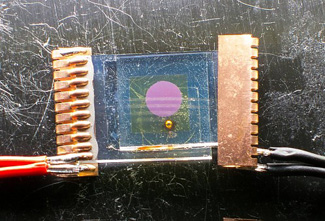Plain Jane Zinc Gives Solar Power a Technicolor Spark
 Researchers from the University of Basel in Switzerland are developing low cost solar cells made with zinc, a cheap and abundant material. Zinc is an uninteresting gray in its natural state, but the team has figured out a way to use it for creating colorful dyes, which could lead to the next generation of cheap, dye-sensitized solar cells.
Researchers from the University of Basel in Switzerland are developing low cost solar cells made with zinc, a cheap and abundant material. Zinc is an uninteresting gray in its natural state, but the team has figured out a way to use it for creating colorful dyes, which could lead to the next generation of cheap, dye-sensitized solar cells.Coloring the way to low cost solar
The use of dyes to boost solar cell efficiency has been the subject of intense research for the past several years, but until now zinc has been somewhat overlooked. Lead researcher Ed Contable has admitted that “most chemists consider zinc to be a ‘boring’element,” since most of the compounds derived from it are relatively colorless.
A cheaper foundation for dye-sensitized solar cells
According to the University of Basel, ruthenium dyes are used in typical dye-sensitized solar cells. However, ruthenium is a “transition metal” that shares some characteristics with platinum, including a sky-high price tag.
Current prices for ruthenium run about 3,500 Swiss Francs per kilogram, and the research team had begun experimenting with a copper substitute at only 7.5 Francs. Based on the success of those experiments, they searched for an even cheaper substitute and settled on zinc at 1.8 Francs.
Combining two steps into one
In addition to using a new material, zinc, the Basel team also departed from the normal fabrication processes that are typically used to make dye-sensitized solar cells. Rather than creating dyes separately, they developed a method for synthesizing zinc-based dyes while in the process of attaching zinc to microscopic particles of titanium dioxide.
The titanium dioxide acts like a semiconductor, which accepts electrons that have been absorbed by the dye.
At this stage of the research, the conversion efficiency of the new solar cell is pretty low, so the Basel team has its work cut out for it.
Titanium dioxide to the rescue
If titanium dioxide rings a bell, that’s because it is another cheap, abundant material (widely used in paint and toothpaste, among other things) that has been helping to push new clean technology off the lab table and into the real world.
Titanium dioxide is also being used in hydrogen fuel cells, and it can be used to neutralized pollutants, a couple of examples being the “pollution-eating” coatings for buildngs developed by aluminum giant Alcoa, and pollution-fighting road surfaces developed by the company Pureti.
You can return to the main Market News page, or press the Back button on your browser.

